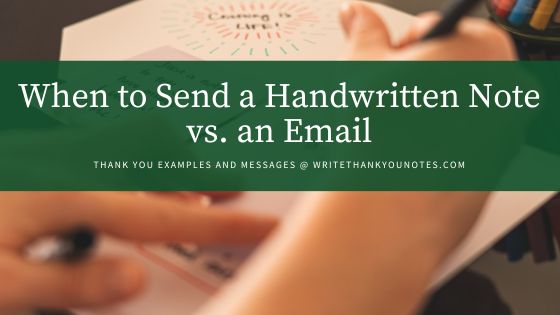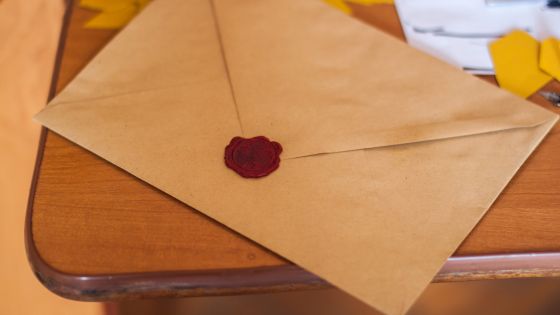Picture this: you receive a beautifully crafted handwritten note in the mail. It’s not a bill, not a flyer, but a genuine thank-you note from a friend. Instantly, you feel appreciated and valued.
In an era dominated by digital communication, the choice between sending a handwritten note or an email can be a modern dilemma but one that is easily resolved by thinking about the effect you want to create.
So, when is it more appropriate to send each? Let’s dive into the nuances of expressing gratitude in the digital age.
The Power of Gratitude
Thank-you notes are more than just polite gestures. They strengthen relationships, boost our mood, and remind us of the good in our lives. A simple note of thanks can make someone’s day, turning a mundane moment into something memorable.
 That disembodied hand looks kinda weird there.
That disembodied hand looks kinda weird there.
The Case for Handwritten Notes
Personal Touch
Handwritten notes have a special kind of magic. They show effort and thoughtfulness. Imagine receiving a handwritten note after helping a friend move. It feels personal, tangible, and heartfelt. The time taken to write, the choice of paper, and even the handwriting itself all contribute to a unique, personal touch.
Occasions for Handwritten Notes
There are certain times when only a handwritten note will do. Milestones like weddings, graduations, and significant anniversaries call for the personal touch of a handwritten note. Professional achievements, like promotions or awards, also benefit from this sincerity. And when someone goes above and beyond for you, a handwritten note can adequately convey your deep appreciation.
The Convenience of Emails
Speed and Accessibility
Emails, on the other hand, are all about convenience and speed. Need to thank someone quickly? An email can be sent in seconds, making it perfect for timely expressions of gratitude. When your coworker covers for you last minute or a client sends you important information swiftly, a quick thank-you email is both appropriate and appreciated.
Appropriate Situations for Emails
Emails shine in everyday gratitude. When thanking a colleague for a routine favor, or acknowledging a client’s prompt response, emails are effective and sufficient. In professional settings where email is the primary mode of communication, sending a thank-you via email is not only acceptable but expected. And when an immediate acknowledgment is needed, an email is the way to go.
Deciding Factors: When to Choose Which
Relationship with the Recipient
Consider the nature of your relationship. For personal relationships, a handwritten note may convey a deeper level of appreciation. For professional acquaintances, especially in environments where digital communication is standard, an email is often more practical.
Nature of the Occasion
The formality of the occasion matters. Formal events and significant milestones often deserve the extra effort of a handwritten note. Casual interactions and everyday exchanges might be better suited for the quick convenience of an email.
Effort and Authenticity
Handwritten notes inherently show more effort, which can make them more meaningful. However, authenticity can shine through in both formats. A well-crafted email, personalized and sincere, can be just as impactful as a handwritten note.
Crafting Effective Thank-You Notes
Handwritten Notes
When writing a handwritten note, focus on being heartfelt and personal. Use quality stationery to make the note feel special. Mention specific details about what you’re grateful for and why it matters to you.
Emails
For thank-you emails, keep it sincere and concise. Start with a warm greeting, clearly state your gratitude, and end on a positive note. Pay attention to your subject line, and keep your tone friendly yet professional.
Real-Life Examples
Success Stories
Take Sarah, who sent handwritten thank-you notes to all her wedding guests. The personal touch made each guest feel truly appreciated, and many still mention those notes years later.
On the flip side, John, a project manager, regularly sends thank-you emails to his team after completing projects. His timely and sincere messages keep morale high and reinforce a culture of appreciation.
Lessons Learned
Both Sarah and John have learned that the medium of the message can amplify its impact when chosen thoughtfully. Handwritten notes are cherished for their personal touch, while emails are valued for their immediacy and convenience.
So, to email or to handwrite your thank-you note?
In the end, whether you choose to send a handwritten note or an email depends on the context and your intention.
Think about your relationship with the recipient, the nature of the occasion, and the message you want to convey.
Both formats have their strengths, and using them thoughtfully can make your expressions of gratitude even more powerful. So, next time you want to say thank you, consider your options and choose the one that best fits the moment. Happy thanking!
Related:
Your Guide to Writing Bridal Shower Thank-You Notes




